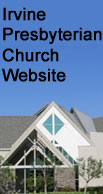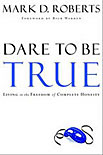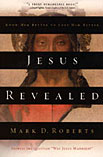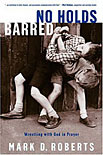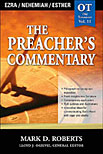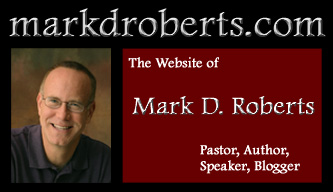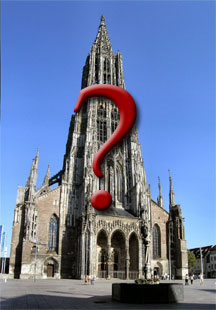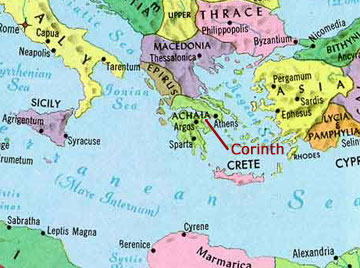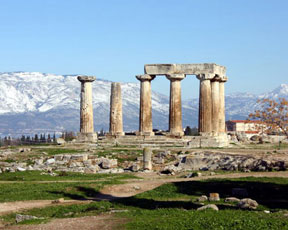| |
A Resource by Mark D. Roberts |
|
What is a Church? What is the Church? Church Basics. Basic Ecclesiology. Introduction to the Church.
What
is a
Church?
Biblical
Basics
for
Christian
Community
Section 2
|
|
|
by Rev. Dr. Mark D. Roberts
Copyright © 2006 by Mark D. Roberts
Note: You may download this resource at no cost, for personal use or for use in a Christian ministry, as long as you are not publishing it for sale. All I ask is that you give credit where credit is due. For all other uses, please contact me at mark@markdroberts.com. Thank you.
A Church of Feet and Ears 
Part 13 of series: What is a Church? Biblical Basics for Christian Community 
Posted for Tuesday, October 24, 2006
Recap: In this series I'm trying to discover what the Bible says about the local church. What is, or better yet, what should this odd collection of people we call a church be like? What is the nature of a Christian community, according to Scripture?
So far I've examined in detail the meaning of the Greek word ekklesia, which is usually translated as "church" in our Bibles. In my last post I noted that Paul's letters to the Colossians and to the Ephesians talk about the church in terms of a body, with Christ as the head. This points to the next stop in our tour of New Testament images for church. But we won't start with Colossians and Ephesians, since these are some of Paul's later letters. (Yes, I'm aware that some scholars believe them to be written by one of Paul's disciples, but I'm not one of them.) Rather, we'll start with 1 Corinthians, the oldest extant reference to the gathering of Christians as a body.
Paul wrote 1 Corinthians sometime in the mid-50s A.D. Previously he had ministered there, perhaps for around a year and a half, leaving behind a collection of believers in Jesus. After Paul left town, these folks continued to meet together in a regular gathering (ekklesia), or perhaps in several groups located in various homes.
Life among the Corinthians Christians wasn't altogether happy, however. Though they experienced Christ's presence and power through the Spirit, they had a hard time getting along together. After greeting the Corinthian ekklesia and offering a prayer for them, Paul jumps into the core of their turmoil: |
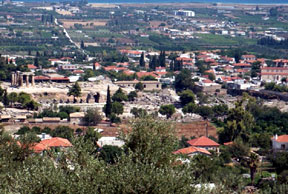
|
| |
Ancient Corinth in foreground. Modern Corinth in background. Copyright © Holy Land Photos.org |
Now I appeal to you, brothers and sisters, by the name of our Lord Jesus Christ, that all of you be in agreement and that there be no divisions among you, but that you be united in the same mind and the same purpose. For it has been reported to me by Chloe’s people that there are quarrels among you, my brothers and sisters. What I mean is that each of you says, “I belong to Paul,” or “I belong to Apollos,” or “I belong to Cephas,” or “I belong to Christ.” (1 Cor 1:10-12)
Paul was writing to the Corinthians from Asia Minor (modern Turkey). While ministering there, he had received a visit from "Chloe's people," who were probably members of her household, perhaps relatives, servants, or slaves, though we can't be quite sure. They brought bad news of divisions among the Corinthian Christians. This may not have been the first Paul had heard of this, because he had also received as visitors three men from Corinth (1 Cor 16:17). These people had, among other things, delivered to Paul a letter from the Corinthian Christians (1 Cor 7:1). The combination of reports and letter concerned Paul greatly, especially as they related the disunity among the Corinthian believers. So he decided to write the letter we know as 1 Corinthians. (In fact, however, it was at earliest the second of Paul's letters to these believers; see 1 Cor 5:9).
One of the main things Paul intends to do in 1 Corinthians is help the young Christians there understand who they are together. We would say: Paul wants them to know who they are as a church. Yet he doesn't do this by drawing out the deeper implications of the word "church" (ekklesia). Rather, Paul uses the image of the human body as a way of explaining how the Corinthian Christians are related to each other, and therefore how they should in fact treat each other in their gatherings. Their likeness to a body makes clear the fact that they should be unified rather than divided. It also suggests how they can achieve unity in a practical way.
Before I get to Paul's teaching about the church as a body, however, I need to say a few things about Corinthian society, and why this may have led to divisions in the Corinthian ekklesia. I'll do this in my next post.
Comments on What is a Church?
If you would like to comment on what I've written here, or to read other comments on this series, click here. (Note: You'll need to register to make comments. You can read anonymously.) |
A Church of Feet and Ears, Section B 
Part 14 of series: What is a Church? Biblical Basics for Christian Community 
Posted for Wednesday, October 25, 2006
In my last post I began to explain why the Apostle Paul wrote to the Christians in Corinth, and why he used the image of the human body to help them understand who they were as God's people together. The core problem was that of division in the Corinthian ekklesia, with members treating each other in an unloving manner and failing to value their connectedness in Christ.
| The more you learn about Corinthian culture in the first century A.D., the less you are surprised by the problems occurring among the Christians there. Corinth was located in southern Greece, in a prime location for travelers and merchants moving across the Mediterranean Sea. Thus Corinth was a hotbed of economic opportunity, unlike much of the rest of the Roman Empire. Lots of new money, and all that often comes with it: pride, boasting, extravagance, prejudice, resentment, selfishness, sexual adventurism, etc. |
|
| |
Corinth in the Roman Empire |
Moreover, because of Corinth's location and economic vitality, it was a truly multicultural city, with immigrants from throughout the Roman world. With multiculturalism came all sorts of adventures and challenges, including foreign religions, different languages, and conflicting cultural patterns. The religious life of Corinth was suitably varied, with vestiges of older Greek religion and its mysteries, as well as lots of newer cults brought by immigrants and visitors. Among those who brought their religion to Corinth were some Jews who had built a synagogue there. (If you're looking for more information on the Corinthian culture and its impact on the Christians there, see the outstanding commentary by Ben Witherington, Conflict and Community in Corinth.)
Given what I've said about the diversity and unsettled nature of Corinthian society, it shouldn't be surprising to learn that the Christian gatherings weren't without their challenges. After all, if you were to bring together people from different socio-economic brackets, religious backgrounds, and ethnicities, and put them in close fellowship with each other, and supply only minimal leadership, then you would surely find yourself with a mess. And that's what Paul experienced with the Corinthians.
Please understand that I'm not necessarily criticizing the Corinthian believers for this situation. After all, they were relatively immature Christians when Paul left their city to plant churches elsewhere. They didn't have Bibles, since the New Testament wasn't written yet, and they would have had at most very limited access to scrolls in the local Jewish synagogue. They didn't have mature Christians to lead them (except perhaps for a few visiting missionaries). They didn't have Christian books, tapes, CDs, DVDs, or websites. What they had was a memory of Paul's teaching, some of which they misunderstood or found confusing, and the presence of the Holy Spirit.
I'm not minimizing the value of the Holy Spirit, mind you. Indeed, there is not better resource for Christian community that the third person of the Trinity! But the problem is that Christians, especially immature ones, can easily get confused about the Spirit. They can attribute to the Spirit works of the flesh, or even of demons. They can claim for themselves spiritual inspiration when none is truly to be found. And this is exactly what happened at Corinth.
In my next post I'll say a bit more about the specifics of this Corinthian confusion about the Spirit, and how it relates both to their culture and to the divisions within the Corinthian ekklesia. Then we'll be ready to dive into Paul's teaching on the church of feet and ears.
Comments on What is a Church?
If you would like to comment on what I've written here, or to read other comments on this series, click here. (Note: You'll need to register to make comments. You can read anonymously.) |
A Church of Feet and Ears, Section C 
Part 15 of series: What is a Church? Biblical Basics for Christian Community 
Posted for Thursday, October 26, 2006
In my last couple of posts I've been describing the historical and cultural context for the letter we know as 1 Corinthians. I explained how the Corinthian congregation was divided, and how the culture of Corinth undoubtedly contributed to this problem. Today I want to focus a bit more closely on the issues that led Paul to use the image of the human body as a way of talking about the church in Corinth.
As we read through 1 Corinthians, it's obvious that some of the Christians there were majoring in what we would call self-centeredness. They were going to do what they wanted to do, without concern for how their behavior impacted others. If, for example, they ate meat in pagan temples and this scandalized their fellow Christians, tough! If some of the men in Corinth participated in prostitution, tough! Some in Corinth were going to enjoy their freedom in Christ whether it hurt others or not. Tough luck for the rest!
This was especially true when it came to the matter of behavior in the ekklesia, the gathering of Corinthian believers. In 1 Corinthians 11, we learn that some of the women were dressing immodestly in the assembly, even though this scandalizes the men who were present. And when it came time for the assembly to share in the Lord's Supper together, which they did in the context of an actual meal, some folks ate sumptuous dinners while others went hungry. |
|
| |
Remains of the Temple of Apollo in Corinth (Copyright © Holy Land Photos)
|
Then there was the matter of purported spiritual experiences and demonstrations. Some members of the Corinthian ekklesia spoke in unknown languages – usually called speaking in tongues – while others did not. A version of this behavior was common in some of the pagan cults that were popular in Corinth at that time. Participants in these cults became so wrapped up in corporate frenzy that they engaged in ecstatic activity, including babbling in unrecognizable syllables. It seems likely that some of the Corinthian believers, believing that speaking in tongues was the apex of spirituality, did so in the Christian gatherings, just as they had once done in their pagan celebrations.
This behavior was disruptive and not helpful to the rest of the gathered believers. Moreover, if an outsiders were to visit an ekklesia and hear such behavior, they'd be inclined to dismiss the Christian community as one more odd Corinthian cult.
Yet those who spoke in tongues not only failed to see how their behavior in the gathering was unhelpful, but also tended to see themselves as spiritually superior to the believers who didn't speak in tongues. Some of these self-appointed elite may even have thought that those who didn't speak in tongues were not even important at all. And it seems likely that those who lacked such demonstrations of spiritual influence also devalued themselves.
So spiritual self-centeredness became mixed up with spiritual pride. The net result was hurting the Christian community in Corinth, especially when they came together for common meetings. Paul's task in response to this problem was a tricky one. For, on the one hand, he agreed with the selfish Corinthians that the Holy Spirit empowered Christians in unusual ways, including speaking in tongues. Yet, on the other hand, Paul saw the value of such spiritual demonstrations in very different terms. In order to help the Corinthian Christians to have a right understanding of how they were to relate to each other, and how, in particular, they were to employ demonstrations experiences in the ekklesia, Paul used the image of the church as a body.
In my next post I'll begin to examine how this image functions in 1 Corinthians.
Comments on What is a Church?
If you would like to comment on what I've written here, or to read other comments on this series, click here. (Note: You'll need to register to make comments. You can read anonymously.) |
Home
|



